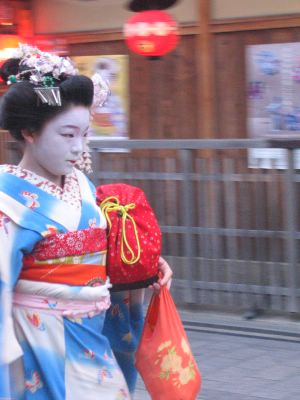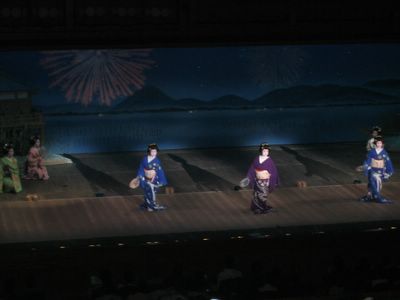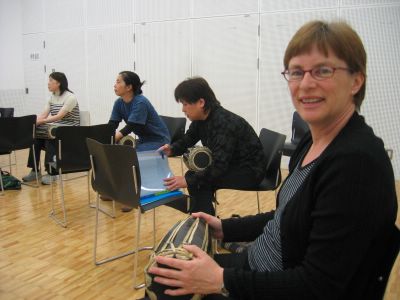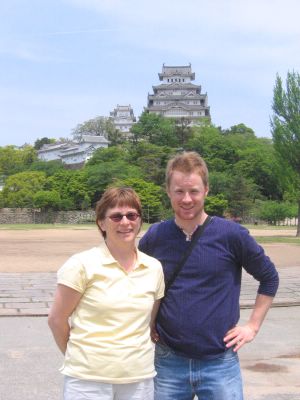Onegaishimasu
The Amazing Adventures of Jon and Nancy
Monday, May 30, 2005
Since I have came to Japan and read "Memoirs of a Geisha" by Arthur Golden, I have been trying to get a good picture of one in the flesh - or more like in the porcelein. They walk so poised and fast. I have seen geisha (or maiko) on 4 different occasions but have never been able to take a very good picture. This May my day came not only because I finally got a good picture but also because we (Joanna, Jon, and I) were able to watch the very famous geisha (or maiko) cherry blossom dance called Miyako Odori.
Monday, May 23, 2005
Learned today that I didn't win the 13th Annual Jet Programme Essay Competition. Here, then, is my losing essay.
A Song and a Smile
*****
The night before my JET interview six centimeters of snow fell and with it the temperature – minus 35 degrees Celsius the morning I left my aunt's acreage, forty minutes from the interview site in downtown Edmonton. Backing out of her long country driveway, I managed to bury my car in a snow bank. My girlfriend Nancy, who also had an interview that day, took the wheel while I pushed. The car wouldn't budge. Frantic, we flagged down an elderly couple who happened by on their way to the church bake sale. They dropped us at the nearest gas station where we called a tow-truck who pulled us back onto the road. Somewhere between driving into the ditch and being hauled out, though, our vehicle's heater took a vacation. On the highway, my toes were the first to go numb. Walking into the interview, I feared my legs would have to be amputated. One of my interviewers promptly nicknamed me the Popsicle. Then he asked if I knew the words to "Twinkle, Twinkle Little Star" and would I mind singing a few bars?
I remember thinking, as I broke into song, "What a strange thing to be doing for a job." But then JET isn't so much a job as a life choice, a radical departure from what came before and what becomes possible after. For me, it meant diving headfirst into a great unknown: a language I didn't speak, food I'd never eaten, people I'd never met and music I'd never heard. I boarded the plane for Tokyo with only a vague notion of why. I knew that it had to do with teaching English, although I'd heard rumors that something called 'internationalization' was of equal importance. But who ever heard of that? And what did it have to do with "Twinkle, Twinkle Little Star"?
*****
After only a short while in Japan, I started to notice music everywhere. Of course, there was karaoke at every opportunity. But it went deeper than that. I learned that the blind roar coming from the mountains was actually cicada chirp. After work, I studied Japanese to the random tooting of the school brass band. I took notice of supermarket jingles and began humming the meat ditty and the mushroom song during school cleaning time. At undokai, I was baffled by both "Rajio Taiso" and the warm-up for which it was designed. As nights became cooler and quieter, I woke for the first time to the forlorn and desperate whine of the ramen truck. Later, I followed with amazement the low, guttural chants which would, on occasion, drift from beyond closed temple doors. I was romanced by the thunderous boom of the taiko drum, the soft shrill of the shamisen. And finally, I was introduced to Kitazoe Shigeru-san and the madal he brought back from Nepal.
Shigeru-san lives with his wife Aya-san in a beautifully restored farmhouse on the only road passing through Togano, a small town in rural Kochi Prefecture. Their home doubles as a coffee and crafts shop specializing in Southeast Asian goods. Indian incense mingles with freshly brewed coffee. Thai silks hang from stained cedar beams 120 years old. Balinese djembes and Nepalese madals compete with bamboo mats and rosewood masks and Bob Marley T-shirts for retail space. It is a thoroughly international setting out there with the frogs croaking in the rice paddies.
In his younger days, Shigeru-san toured Japan and Europe as the drummer for a band fusing traditional Southeast Asian music with American jazz. He traded his tour bus in for a family, though, and now conducts drum workshops in a spacious soundproof room on the second floor of the community hall in Sakawa. Nancy and I attend the Thursday night class, which has only one other member. Together the four of us have moved from the basics of the madal to ever more advanced rhythms. But the heart of the lesson – what we've been practicing since beginning almost a year ago – are the folk songs Shigeru-san holds dear to heart. Through Shigeru-san and these songs I've come to understand what is meant by internationalization.
*****
I didn't know this at first, but the trick is to start slow. At elementary school, I begin with a big, friendly, "Hello!" Then, I move around the room and shake hands and bellow greetings, sometimes throw stuffed animals to the little cuties. Slowly, I reach into my pocket and pull out a pair of toy keiteis, one for me and one for a lucky volunteer. Together we review our hello's and good morning's, get to know one another. I quit while the yaritai chorus is still strong and move on to the lesson. First, I review some words they already know. Then, I teach a phrase. I invent a song and dance that will help them remember, demonstrate the game to be played and then, when everyone is good and tired from running all over, we sit down together and review again. I realize it isn't what they're used to and that the homeroom teacher may not always appreciate or even understand what is going on, but the kids seem to enjoy it and they always seem to learn something. I like to think of that as the point.
It's different at junior high school. It isn't enough that they learn only something. The students have to learn English. More specifically, they have to learn what is going to appear on the test. The result is textbook-based classes where the students listen and repeat, listen and repeat, leaving little to the imagination. It isn't necessarily exciting, but it works. There are times when the textbook isn't anywhere to be seen and what transpires is actual communication. The students are at an imaginary restaurant, for example, and they want to order something that isn't on the menu so they mine their vocabulary for some words that, if they mash them up somehow, might get them what they want and, sure enough, the ALT understands! What seemed arbitrary and useless and just a touch on the boring side suddenly has a use. The sentence patterns can be applied. Communication can be achieved and this English stuff actually makes sense and if I just speak it people can understand me and I can get what I want. It isn't impossible or stupid and wow! maybe there is a point after all.
*****
The madal is simple enough. It is a two-sided drum used to keep rhythm in traditional Nepalese music. The body of the drum rests on the drummer's lap so that a large goat-skinned drum head is on the left with a smaller one on the right. The drum heads are held in place by raw hide that crisscrosses the body of the drum. The madal is tuned by pulling on these ropes, the left side tuned lower than right, bass and tenor. In the middle of each drum head is a black patch made of powdered manganese mixed with rice flour. The weight of this metallic patch creates what Shigeru-san calls the "madal sound", similar to the ringing of a bell, but deeper and with less sustain. Also, hitting and holding the drum head with an open palm creates a slap noise. Similarly, striking the body of the drum creates a kind of clap-rattle. Four sounds, then: bass, tenor, slap and clap-rattle.
Shigeru-san immediately set to teaching the rules. First was how to make the madal pronounce: by holding the hands like limp claws and snapping so the drum rings long after fingertips have left the drum surface. Next was what the drum sounds like when translated into language: ton (bass), ta (tenor), tsu (slap) and chi (clap-rattle). We tried a simple Nepalese rhythm: ton, tsu, ta, tsu, ton, ton, ta. He handed out our sheet music, the lyrics to a Japanese song entitled "Shabondama". At first I couldn't pronounce a word of this song about a soap bubble. I certainly didn't know that the soap bubble was meant to signify the death of the author's child and that, over the years, the song has become a piece of the Japanese identity , is played on TV shows and at funerals for the young. But I liked it, and I liked playing the madal. So, I kept practicing.
*****
"English is a puzzle." I got this in conversation from a third year junior high school student. All I asked was, "Do you like English?" I wonder, though, do all the students I visit see English as a puzzle? I've heard them say that English is difficult, that they hate English. Or, that English is fun and that they love English. At elementary school, I've heard them inventing new words on the playground, more often than not for incorporation into their own language – bi-kyuu (a combination of goodbye and thank you) and mayoneeze ketchappu sousu ( My name is Ketchup Sauce) are two of my favourites. Or the time I was kicking a soccer ball thirty feet into the air for the children to chase after and two months later, when I returned, the first graders all asking for the, "Jon Super Kick. Please Jon, super kick." I still don't know where they learned that one from. I like to believe that they just knew; that somehow they simply puzzled it together.
*****
As the weeks progressed, we learned the drums to "Furusato," "Akai Hana, Shiroi Hana," "Ojiisan no Furodokei," "Yume no Naka e," "Uchi no Otousan," and a host of others. I was supposed to sing and play the drum, but I'd never heard of any of the songs before and, naturally, had a difficult time keeping the melodies and lyrics straight. Shigeru-san worked hard to help me remember: there were days when I listened to and repeated every single line of every single song. Boring perhaps, but necessary, because it eventually got to where I could hum a few bars at school, at which point a concert would invariably break out. During cleaning time, students would teach me the words and laugh at my mistakes, my nantoka-ing through the hard parts. They laughed, but I could tell they were impressed. Each time I learned a new line to a song, a barrier came down. And the look on their faces when I sang something even they didn't know! In song I found a common ground with the people around me.
In November Shigeru-san announced a concert for the end of February . From now, we would really practice. Our Thursday night workshop, normally a two hour lesson, joined with the workshop after ours and continued for another two hours. Our group of four ballooned to become a twelve person jam band that, for one reason or another, didn't really say much to one another. One night, though, we decided to make a mini-disc so Nancy and I could practice singing at home. We hooked a lone microphone to the back of a chair and arranged ourselves in a circle. I don't know why, but the twelve of us came together then in our little homemade studio. We sang and played together, made mistakes and laughed together. We stayed until eleven o'clock together, and together we finished our recording of that evening in the little soundproof room in the town hall at Sakawa. Three weeks later our group joined with every workshop of the night and for three hours Nancy a nd I were simply two of the nearly forty people gathered to sing a song about a soap bubble.
*****
Last summer Nancy and I returned to Canada to visit friends and family. Luckily, we chanced upon the yearly Saskatoon Fringe Festival. We spent two days wandering the festival grounds, soaking up the atmosphere: fire breathers, street jugglers, break dancers and, of course, the hundreds of theatre troupes from around the English speaking world. Near the end of the second day we found ourselves all played out and hungry for some relaxation. We stopped at the First Nations pavilion, where I bought a buffalo meat burger served on a wood-fired bannock bun. After sitting down to eat , a casually dressed older couple took the stage set in the middle of a sparsely peopled patch of grass. He banged a small frame drum adorned with eagle feathers and multi-coloured beads and together they sang the most beautiful Cree songs. I couldn't understand a word, yet I understood everything they had to say. That f luency runs deeper than language and depends on simple curiosity and a healthy desire for the unknown . That if we approach one another with the willingness to be both a teacher and a student, then real communication is possible. Listening to the music that night, I realized what Shigeru-san had been teaching all along.
Monday, May 16, 2005
Haruki Murakami, writing in The Incredible Wind-up Bird Chronicle:
... The father was convinced that the only way to live a full life in Japanese society was to earn the highest possible marks and to shove aside anyone and everyone standing in your path to the top. He believed this with absolute conviction.
... All men are not created equal, he said. That was just some righteous-sounding nonsense they taught you in school. Japan might have the political structure of a deomocratic nation, but it was at the same time a fiercly carnivorous society of class in which the weak were devoured by the strong, and you unless you became one of the elite, there was no point in living in this country. You'd just be ground to dust in the millstones. You had to fight your way up every rung of the ladder. This kind of ambition was entirely healthy. If people lost that ambition, Japan would perish. In response to my father-in-law's view, I offered no opinion. He was not looking for my opionion. He had merely been spouting his belief, a conviction that would remain unchanged for all eternity.
Wednesday, May 11, 2005
The Japanese may be cultured, but even they aren't above laying claim to the worlds largest insert-really-big-such-and-such. In
More entertaining – although no shorter on rules (I especially like the one that states, in essence, "no funny lookin' people allowed") – is Universal Studios Japan, located on a piece of reclaimed land in Osaka Bay. It rained the day we went, which actually worked to our benefit, as there wasn't as big a crowd. Near the end of the day, it was possible to take rides back-to-back, without any wait what-so-ever. Personal favourite:
And then what else? Well, we boarded the shinkansen (really fast train) to
Saturday, May 07, 2005
Friday, May 06, 2005
I need to sit down and update this thing more often. Now I can’t remember what it is we’ve been up to the past few days. I’ll try anyway and apologize in advance for the suckiness.
After the airport we headed for
The temple was built in the 8th century and is dedicated to the gods of rice and sake. There are stone foxes throughout the complex, as the fox is considered messenger of the god of cereal grains. But the real thing to see is the four kilometer path lined all the way with red torii gates. I’m too lazy to think of something clever describing how cool it was, so you’ll just have to take my word for it.
Later that day we toured Sanjusangen-do, which has 1001 people-sized wood carvings of Kannon. No pictures were allowed and my words won’t do it justice, either. The best I can do at this late hour is to say that it, too, was cool. Sorry and good night.
























